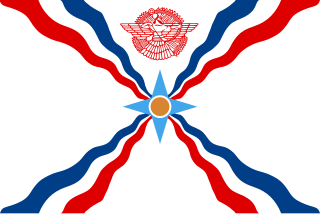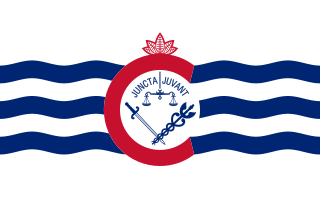
The national flag of the Netherlands is a horizontal tricolour of red, white, and blue. The current design originates as a variant of the late 16th century orange-white-blue Prinsenvlag, evolving in the early 17th century as the red-white-blue Statenvlag, the naval flag of the States-General of the Dutch Republic, making the Dutch flag perhaps the oldest tricolour flag in continuous use.As a flag that symbolises the transformation from monarchy to republic, it has inspired both the seminal Russian flag, and after the French Revolution in 1789 the vertically striped French Tricolor, which in turn influenced many other tricolours. During the economic crisis of the 1930s, the old Prince's Flag with the colour orange gained some popularity among some people. To end the confusion, the colours red, white and blue and its official status as the national flag of the Kingdom of the Netherlands were reaffirmed by royal decree on 19 February 1937.

The national flag of France is a tricolour flag featuring three vertical bands coloured blue, white, and red. It is known to English speakers as the Tricolour, although the flag of Ireland and others are also so known. The design was adopted after the French Revolution; while not the first tricolour, it became one of the most influential flags in history. The tricolour scheme was later adopted by many other nations in Europe and elsewhere, and, according to the Encyclopædia Britannica has historically stood "in symbolic opposition to the autocratic and clericalist royal standards of the past".

West Lafayette is a city in Wabash Township, Tippecanoe County, Indiana, United States, about 65 miles (105 km) northwest of the state capital of Indianapolis and 113 miles (182 km) southeast of Chicago. West Lafayette is directly across the Wabash River from its sister city, Lafayette. As of the 2020 census, its population was 44,595. It is the most densely populated city in Indiana and is home to Purdue University.

The State flag of Republic of the Union of Myanmar was adopted on 21 October 2010.

The flag of Minnesota is the state flag of Minnesota. Its design features a modified version of the seal of Minnesota on a blue field. The first version of the flag was flown from 1893 until 1957, and was changed to be more easily manufacturable, and the state seal became simpler. The current flag was adopted in 1957 and the state seal on the flag was modified in 1983. The flag has been criticized as racist and white supremacist, depicting a white settler displacing a Native American without historical context provided about violence against Native peoples. A bill has been proposed in the 2021–2022 session of the Minnesota Legislature that would create a new task force to discuss possibilities for flag modification and replacement.

The flag of Chicago consists of two light blue horizontal bars, or stripes, on a field of white, each bar one-sixth the height of the full flag, and placed slightly less than one-sixth of the way from the top and bottom. Four bright red stars, with six sharp points each, are set side by side, close together, in the middle third of the surface of the flag.

The Assyrian flag is the flag chosen by the Assyrian people to represent the Assyrian nation in the homeland and in the diaspora.

The flag of Indianapolis has a dark blue field with a white five-pointed star pointing upwards in the center. Around the star is a circular field in red. Surrounding the red field is a white ring, from which extend four white stripes from top to bottom and from hoist to fly, thus creating four equal quadrants in the field. The stripes are about one-seventh the width of the flag, with the white ring the same width as the stripes. The diameter of the red circle is about two-ninths the width of the flag.

The flag of Des Moines, Iowa, was designed by Walter T. Proctor. Set on a blue background is a red vertical stripe along the hoist with the right side of the stripe angling inward toward the hoist and a white balance of three horizontal "bridges."

The flags of New York City include the flag of New York City, the respective flags of the boroughs of The Bronx, Brooklyn, Manhattan, Queens, and Staten Island, and flags of certain city departments. The city flag is a vertical tricolor in blue, white, and orange and charged in the center bar with the Seal of New York City in blue. The tricolor design is derived from the flag of the Dutch Republic—the Prince's Flag (Prinsenvlag)—as used in New Amsterdam in 1625.

The flag of St. Louis, Missouri, consists of a solid red background and three thick, wavy lines colored blue and white extending from the top left corner, bottom left corner, and center right edge. At the intersection of these lines there is a yellow disk containing a blue fleur-de-lis.

The flag of China, officially the National Flag of the People's Republic of China, also known as the Five-star Red Flag, is a Chinese red field with five golden stars charged at the canton. The design features one large star, with four smaller stars in an arc set off towards the fly. It has been the national flag of China since the foundation of the People's Republic of China on 1 October 1949.

The flag of Cincinnati is the municipal banner of the city of Cincinnati, Ohio, in the United States. The design was selected in an 1896 contest. It was formally adopted on June 15, 1940.

The flag of Fort Wayne, Indiana, was adopted as the city's official flag by City Council on June 26, 1934. The pall design includes two diagonal white stripes converging in the circular center to form a horizontal white stripe. Red silhouettes of a Miami Native American head, a French fleur-de-lis, and a British lion grace a navy blue field. A red blockhouse is located at the center of the converging stripes, with the settlement's founding date and city name.

The flag of Tulsa consists of an upper navy blue half and a lower beige half, separated by a gold horizontal line, with a gold Osage shield punctuating the left third. The shield contains a red circle, and a beige six-pointed star centered within the circle. The flag is notable for being one of the few modern flags to utilize beige in its design - a color often associated with faded dyes on flags from usage.

The flag of San Antonio is the official municipal flag of San Antonio, Texas. The sketch of the flag's design, drawn by Spanish–American War veteran William W. Herring, was dated May 28, 1933. The design saw significantly more usage than the official flag, but was never officially adopted until 1976. The current flag is a slightly modified version of Herring's design, most notably removing the text formerly displayed.

The flag of Austin is the official municipal flag of Austin, Texas. The flag simply consists of a white field with the seal of Austin without the surrounding circle of text. Below the seal of Austin is the text, "CITY OF AUSTIN", written in blue and arched upwards.

The flag of Columbus is the official municipal flag of Columbus, Ohio. Its current design is a yellow, white, red vertical triband with the city seal on a blue field. Officially, the flag was adopted in 1929, although it is unknown if the flag was ever flown when it was first adopted.

The flag of South Bend, Indiana, was adopted by the city council during the mayorship of Pete Buttigieg on April 25th, 2016. It is a field of white and yellow separated by a two blue curved lines with a white line between them and a red six-pointed star in the upper left corner.

The flag of Pocatello is the official flag of the city of Pocatello, Idaho, United States. The present flag was adopted on July 20, 2017, replacing the previous flag, used from 2001 to 2017. The former flag was considered by a 2004 survey of the North American Vexillological Association to be the worst of 150 selected US city flags. The current flag is commonly known as the Mountains Left, while the previous flag used until 2017, was known as the Proud to be Pocatello.




















